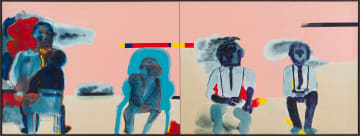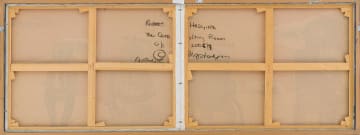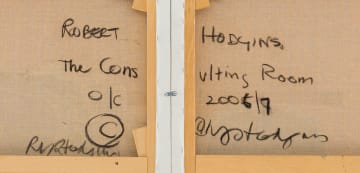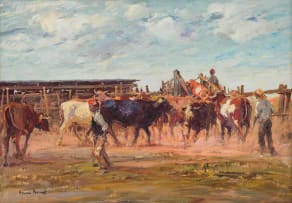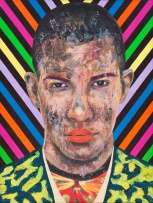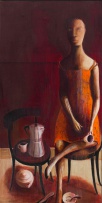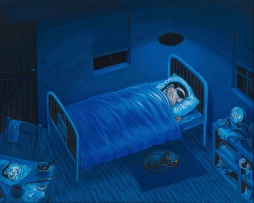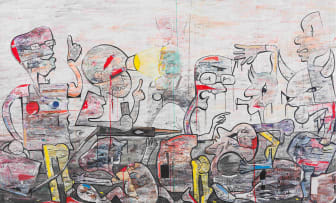Consulting Room
Robert Hodgins
Incl. Buyer's Premium & VAT
About this Item
dated 2006/7 and inscribed with the artist's name and the title on the reverse
Notes
The idea of order and chaos plays itself out in the present lot, Robert Hodgins' largescale work, Consulting Room. In terms of its monumental scale, Hodgins was reacting to a snide comment by Kendall Geers in a review of one of Hodgins' exhibitions, that the artist was incapable of painting on a large scale, and Hodgins retorted with quite a few very large-scale, and rather impressive works. One of them was the triptych, Night of the Awards, with the tart inscription on the back, 'Just as Mr WH [William Herbert, Third Earl of Pembroke] was the 'onlie begetter' of Shakespeare's sonnets, so Mr Kendall Geers is the 'onlie begetter' of this triptych. He declares in public 'Hodgins will never do a painting as big as The Triple Gates of Hell at the Joubert Park Gallery.' He challenges. I accept. This is the result. With affection for K.G.' Consulting Room is another result of this challenge.
Order and chaos are best embodied in the fictitious character of Ubu Roi, invented by Alfred Jarry, the late-19th century French dramatist, and frequently depicted by Hodgins throughout his career. Order is to be found in the grand and lavish palaces of, say, a dictator, and chaos in the way in which the dictator rules his country and messes up his own life and the lives of everybody else, creating a veritable 'madhouse', so to speak. Ivor Powell, writing extensively on the work of Robert Hodgins, maintains in this regard that Michel Foucault, in his famous The Order of Things argued that 'experienced realities, the way in which the world is ordered and understood, are essentially functions of the exercise of power through history. Things needed be the way they are, they are the way they are because they have been made to be that way, because the culturally specific discourse of power has been superimposed upon the stuff of experience.'1 Order is presented in various typical situations in which power games are at play; whether it is the worker in the imposing office of the boss, or whether it is the patient in a doctor's consulting rooms. Power is embodied in the suit of the businessman, or the white coat of the doctor, all basically armour against a cruel world. That is the irony but also the sadness of the businessman and the doctor, an explanation offered many times by Hodgins when he spoke about his art.
What is striking about the present lot, is the manner in which space is articulated on the picture plane: a broken line at mid-level, signifying a hostile and alienating place. The focus of the work, however, is on the one figure standing to the left in a room full of seated figures, possibly the 'doctor' towering over the row of waiting patients. Perhaps another typical power relationship playing itself out in the professional classes, the doctors, the lawyers, the accountants lording it over their clients. The 'doctor' however, seems to have a bleeding heart, judging from the large red spot that is his torso. Before one feels sorry for the figure, however, one is reminded of the words of Neil Dundas, saying 'ignoble nobility, venal popes, untrustworthy clergymen, men in uniforms or formal suits of importance, disguised somehow by their clothing to compensate for their low morals, vicious demeanor, criminal intent, leering manners or lack of compassion, became the order of the day for [Hodgins]. Yet not all was cynicism or condemnation. He regarded ladies of ill repute, men in loud suits, bewildered exboxers struggling with the after-effects of being too often battered, all with a degree of understanding, humour and fellow-feeling.'2 And Powell's words as well: 'the world is stood on its head. And swirling all around the images, catching them in restless swirls and stabs of passion, there is Hodgins' paint. It is deliberately ugly and vivid, shot through with blood and mucus, transposing chaotic inner worlds into outer geography. The world as flesh and flesh as world.'3 This is the world Hodgins depicts so poignantly and elegiacally in Consulting Room.
1. Ivor Powell (1996) Robert Hodgins, Johannesburg, published by Robert Hodgins, unpaginated.
2. Neil Dundas (2019) 'Satire and Irony were the grist mill for this painter…' in Frank Kilbourn (2019) Satire & Irony: Robert Hodgins, Stanley Pinker, Alexander Podlashuc, from the Kilbourn, Block, Wiese and Podlashuc Collections, Cape Town: Welgemeend, page 8.
3. Powell, ibid, unpaginated.


